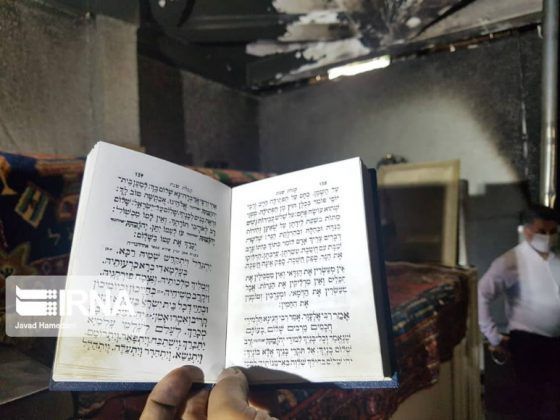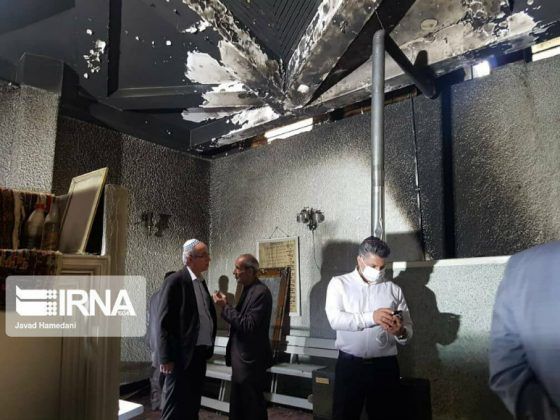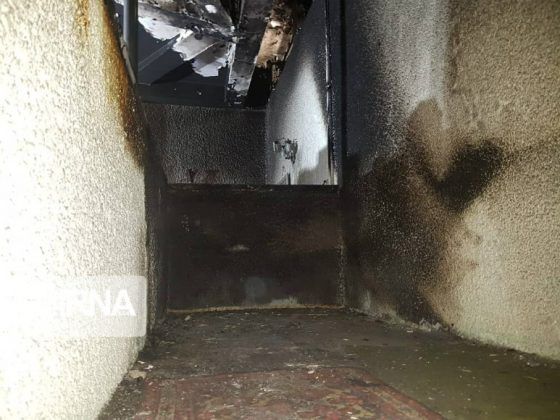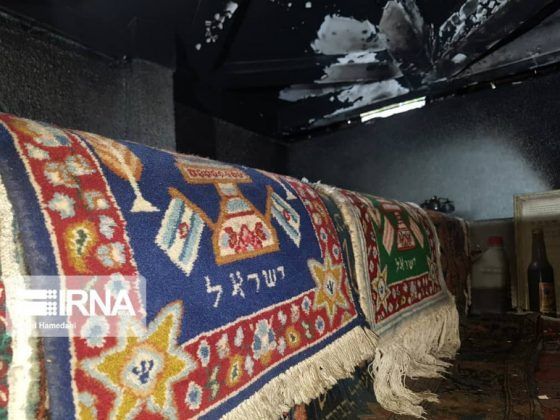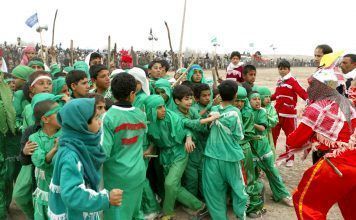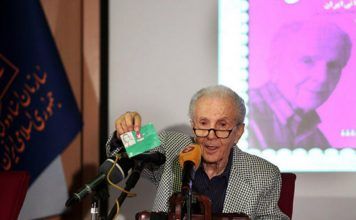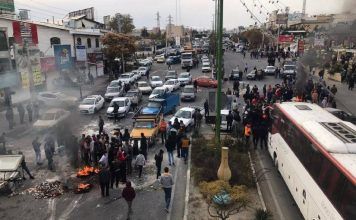On May 14, an unknown person or persons allegedly set fire to the Tomb of Esther and Mordechai in Hamadan, capital of the northwestern province of Hamadan, which is arguably the holiest Jewish site in Iran. The Tomb reportedly houses the remains of the biblical Queen Esther and her cousin Mordechai.
Over the last decade, the site has been targeted repeatedly by extremists who have vandalized on many occasions. While some have suggested that the hostility is rooted in the biblical story of Esther and Mordechai, others say the legend is just an excuse for the radical elements within the regime to terrorize the Jewish community.
Although photographs published recently in the foreign press and broadcast media showed extensive damage done to the Tomb of Esther and Mordechai, the Iranian media played down the incident.
“Contrary to reports by some media outlets, the Tomb of Esther and Mordechai did not sustain any major damage,” the head of the Tehran Jewish Committee Dr. Homayoun Sameh-Yah (also spelled Samehyah) was quoted by the Islamic Republic News Agency (IRNA) as saying. “Religious minorities, especially the Jews, are protected by the Islamic Republic system and are supported by the government. They are grateful for the services the state and the government provide to the Jewish community.”
“The Tomb of Esther and Mordechai is intact,” Dr. Sameh-Yah, who also represents the Jewish minority in the Majlis (Iranian Parliament), noted. “Smoke was detected at a location outside the complex. The incident is under investigation. The enemies of the Islamic Republic have blown the situation out of proportion and launched a negative propaganda campaign against Iran.”
Speaking to IRNA on the same day, the head of Hamedan’s branch of the Cultural Heritage, Handicraft and Tourism Organization of Iran (ICHTO), Ali Malimir, said: “The Tomb of Esther and Mordechai is one of Hamedan’s historical and national heritage sites. The fire had occurred at the building next to the Tomb, damaging the electric wires and the carpet. The main building was not damaged. The repair works, which include rewiring the building, changing the carpet, and cleaning the walls, will start next week.”
Meanwhile, Hamadan prosecutor Hossein Khanjani told the Iranian Students News Agency: “Law enforcement forces have been investigating the incident for the past two days, but have arrested no one yet.”
In the Bible’s Book of Esther, she is described as a Jewish Queen to the Persian King Ahasuerus. The king’s senior advisor, Haman, who despises Esther’s cousin, Mordechai, convinces Ahasuerus to kill all the Jews in the land. Esther, however, foils the plot and persuades the king to allow the Jews to kill their enemies. There are no known historical and factual events in the story. The name Ahasuerus is usually understood to refer to fictionalized Achaemenid king Xerxes the Great (518-465 BC).
A few days earlier, the Majlis approved the double-urgency Bill “Countering the Zionist Regime’s Hostile Actions” in principle. The MPs reportedly agreed to remove Article 11 from the bill that bans Iranian athletes from competing against their Israeli opponents in international championships, arguing that other articles in the proposal addressed the issue.
In comments reported by the Tehran-based Tabnak news website, Mojtaba Zonnour (also spelled Zolnour), a member of the National Security and Foreign Policy Committee of the Majlis, said that the deputies had not given their final approval on removing Article 11 from the bill yet.
Kayhan Life recently spoke with Menashe Amir, the Iranian-born Persian-language broadcaster on Israel Radio International (Reka), about the desecration of the Tomb of Esther and Mordechai and the bill which was recently ratified by the Majlis.
[aesop_image img=”https://kayhanlife.com/wp-content/uploads/2020/05/maxresdefault-2.jpg” panorama=”off” credit=”Source: Kayhan London” align=”center” lightbox=”off” captionsrc=”custom” caption=”Menashe Amir. ” captionposition=”left” revealfx=”off” overlay_revealfx=”off”]
The following is Kayhan Life’s interview with Mr. Amir.
Why do you think religious radicals attacked and set fire to the Tomb of Esther and Mordechai in Hamedan?
For the past 41 years, extremist groups inside the regime have tried to isolate Iran by damaging its relationship with the international community and turning it into a pariah state. These groups’ goal is to fulfill the wishes of the Islamic Republic founder, Ayatollah Ruhollah Khomeini, who famously said he wished that “a wall similar to the one in China could be built around Iran.” That was probably the principal reason behind the student takeover of the American embassy in Tehran six months after the 1979 Islamic Revolution. Subsequently, Mr. Khomeini urged the Shia population in Iraq to rise against [Iraqi leader] Saddam Hussain, which ultimately resulted in the brutal Iran-Iraq War (1980-88).
The incident at the Tomb of Esther and Mordechai is just another example of the regime’s relentless effort to destroy Iran’s relationship with the rest of the world, despite the many urgent problems plaguing the country, including the coronavirus pandemic, the economic crisis, the conflict with the U.S. and crippling sanctions. The latest incident has angered Jewish communities around the world.
Despite being a National Heritage site and one of Iran’s most popular tourist attractions, the Tomb of Esther and Mordechai has been vandalized and desecrated many times since the Islamic Revolution four decades ago. While many Iranians have been celebrating the benevolent and humanitarian deeds of the ancient Persian king Cyrus the Great, fanatics in the Islamic Republic regime have attacked, damaged and even destroyed historic and ancient sites. The story behind the Tomb of Esther and Mordechai dates back to the Persian Achaemenid dynasty. For the past 12 years, the regime’s radical elements have been trying to destroy the close ties between Iran and the Jewish nation.
The extremist elements within the regime believe Esther and Mordechai plotted the murder of many Iranians during the reign of Xerxes the Great. They even tried to link the incident to the 13th day of Nowruz (the Iranian New Year). What is the significance of the story of Esther and Mordechai in Jewish tradition and faith? What is the source of this conflict?
There is no documentary evidence that proves that the place is the actual Tomb of Esther and Mordechai. We do, however, know that the site is a few hundred years old. It is part of Jewish mythology. Devout Jews may find the term ‘myth’ offensive, and argue that the story is from the Book of Esther and part of the Bible. My answer is that the Book of Esther is not included in the Torah (teachings, also known as the Five Books of Moses). It is part of the Hebrew Bible which comprises the Torah, Nevi’im (Prophets), and Ketuvim (writings) — hence the acronym TaNaKh. Most of the individual books in Ketuvim were reportedly written during the period of Persian and Hellenistic rule, from the fifth through the second centuries BC. Most stories have religious significance to the Jews.
The story of Esther and Mordechai is not a historical fact. It is only a legend. The story supposedly takes place during the Achaemenid dynasty, and Ahasuerus may refer to Xeroxes the Great, or Artaxeroxes I (518-465 BC) or Artaxeroxes II (453-358 BC). There is, however, no document or recorded evidence supporting these claims.
According to the Book of Esther, Ahasuerus ruled over a vast territory, which included 127 nations stretching from India to Ethiopia. His first minister, Haman, who was probably from a region around the Aegean Sea, was reportedly a staunch anti-Semite. According to the legend, Haman was offended by Mordechai, who refused to bow down to him during a ceremony at the royal court. Mordechai explained to Haman that in Judaism, one should not bow to another human. Haman, however, tricked the king into approving a plan for killing all the Jews in the land. Esther, who was Jewish, informed the king that Haman had also planned to kill her. That angered the king who ordered Haman, his family, and everyone involved in the plot to be executed.
So the claim that Jews killed 70,000 Iranian is utterly unfounded. The radical elements inside the Islamic Republic aim to discredit the achievements of Cyrus the Great and accuse the Jews of committing the first holocaust. The story is, however, about preventing the murder of the Jews. Most likely, someone in the Islamic Republic regime’s intelligence agency has concocted the story of Jews killing Iranians as a propaganda ploy.
The Book of Esther is not based on actual events. Studies by secular scholars have shown that the story was invented during the Greek empire’s control over Israel. The Jews were despairing during the Greek domination of their homeland. They felt defeated and feared that they were about to be wiped out. A Jewish author created this story to give them hope. The narrative shows that there is light at the end of the tunnel.
Setting the story in ancient Persia shows that the Jews had a particular affinity for the country, its people, culture, and customs. The Jews were familiar with Persia because when Cyrus the Great conquered Babylon 2,500 years ago; he freed the Jews and allowed them to return to their homeland and rebuild it. Some Jews went to Iran instead and made it their new home. They selected a region that had the same climate and terrain as Jerusalem. The place ultimately became a base for the Iranian military. It was named Sepahan, which was later changed to Esfahan.
The legend of Esther and Mordechai shows that the Jews loved Iran so much that they chose it as the backdrop for the narrative.
Has any other Jewish site in Iran had been attacked, desecrated and vandalized?
Although many of the pilgrims to the Tomb of Esther and Mordechai are Muslims, it is one of the most sacred Jewish sites. It belongs to the Jews. There are several sacred Jewish sites in Iran. For instance, the Tomb of Daniel — burial place of the Biblical and Islamic prophet Daniel — in the city of Shush, in the southwestern province of Khuzestan, which is also visited by many Muslims. Although he was a Jewish prophet, there is a plaque inside his Tomb, which quotes Shia’s first Imam Ali, who said, “Those who love me must visit Daniel’s shrine.”
Other Jewish sites have not been damaged. The Tomb of Esther and Mordechai symbolizes the close and historical ties between the Jews and Iranian people, which dates back to the pre-Islamic era, and that is why they have tried to damage it.
[aesop_image img=”https://kayhanlife.com/wp-content/uploads/2020/05/دانیال-نبی.jpg” panorama=”off” credit=”Source: Kayhan London” align=”center” lightbox=”off” captionsrc=”custom” caption=”Tomb of Daniel. ” captionposition=”left” revealfx=”off” overlay_revealfx=”off”]
Many organizations around the world have condemned the recent attack on the Tomb of Esther and Mordechai. How can the international community help to stop these attacks?
Pressures from UNESCO and other international organizations could make the regime understand the severity of these actions. The reports by IRNA show that authorities have tried to downplay the incident at the Tomb of Esther and Mordechai. The officials at the ICHTO have stressed the need to protect the country’s national heritage, showing that some people inside the regime grasp the gravity of the situation and are doing their utmost to prevent such incidents from happening.
The regime has been trying to appropriate the lands around the Tomb for the past four decades. The Islamic Republic is playing with fire, and that is why it is cautious. President Hassan Rouhani would not have condemned the action as strongly as he had if he had not tackled so many problems. In the past, some Iranian leaders, such as the former president Mohammad Khatami, empathized with the Jewish community in Iran. Many officials praised Soleyman Haim’s (1887-1970) Persian to Hebrew dictionary, which was finally published posthumously in 2014.
The regime showcases Iranian Jews’ lives to prove to the world that it treats religious minorities with respect. So, I think the Iranian regime will try to manage this situation and reach a satisfactory conclusion to reassure the Jewish community in the country. The state will continue working to control the curriculum at Jewish schools. For instance, the regime has banned Saturday schools and the teaching of the Torah in Arabic.
In recent days, the Majlis approved the double-urgency Bill “Countering the Zionist Regime’s Hostile Actions.” It reportedly removed Article 11 from the bill that bans Iranian athletes from competing against their Israeli opponents in international championship tournaments. According to an MP, the Majlis did not want to give Israel and the international federations any excuse. What is Iran trying to achieve by ratifying this bill, given the Majlis election is just around the corner? Does the law serve any purpose?
There are two reasons behind this. As you said, there is a parliamentary election just around the corner, and everyone wants to be noticed during this period. The bill aims to weaken Iran’s relationship with the international community and further isolate the regime which ultimately benefits the Islamic Revolutionary Guards Corps (IRGC) and the hardliners who control Iran. The government can tighten its grip over the country once it becomes a pariah state. Removing Article 11 will not reverse the damage the regime has inflicted on the Iranian sport.
The international sports federations will continue to penalize Iran. From now on, no one will give Iranian athletes the benefit of the doubt, even if they cannot face their Israeli opponents for a legitimate reason, such as a health issue. Despite repeated warnings from the International judo and wrestling federations, the hardliners in the regime have achieved their aims. So, it makes no difference if Article 11 is removed or not. The damage is done.
Is there an accurate data on the Jewish community in Iran? How many Jews left Iran after the revolution?
Some 80,000 Jews were living in Iran before the revolution. As many as 60,000 have emigrated to other countries in the past four decades. I believe there are only 6,000 Jews left in Iran, most of whom live in Tehran, Esfahan, and Shiraz. There are not that many Jews living in other Iranian cities.
This article was translated and adapted from Persian by Fardine Hamidi.

